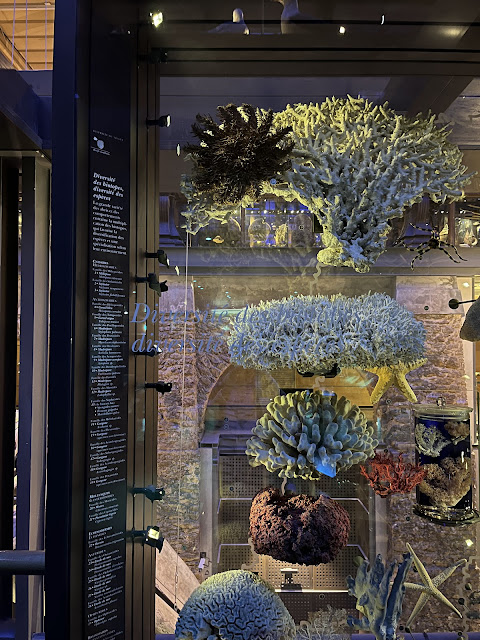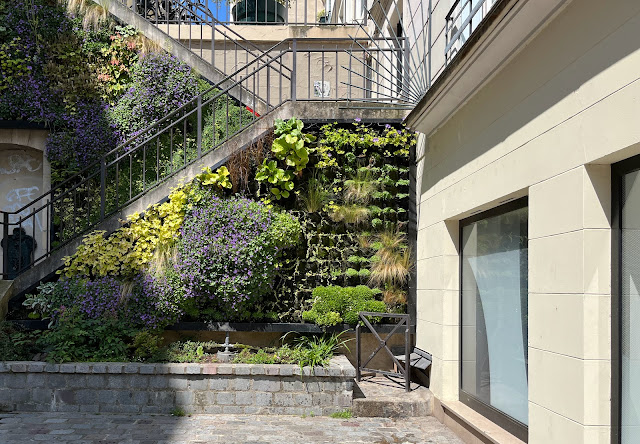A Day in the Fifth
We love having visitors come to town, and one of our favorite activities with them is guided tours of particular parts of the city. (Glenn and I are, of course, the guides.) When our friend A and her daughter visited in April, we put together a walking tour of the 5th, with an emphasis on history and eclairs. I had meant to write a post about our walking tour at the time but never managed to fit it in.
With two different groups of friends in town this past weekend, we reprised the tour of the 5th, and so now I am determined to record some of the details.
We met both groups at around 10am in the Jardin des Plantes to get started. The Jardin des Plantes is a 68-acre public garden on the easternmost edge of the Rive Gauche. It has massive greenhouses, at least two natural history museums, a zoo, and various themed gardens.
We began with a little history: It was established in 1626 as a medicinal garden by Louis XIII. Under the management of Georges-Louis Leclerc, count of Buffon in the 18th Century, it was greatly expanded and became an important center for scientific study of botany and zoology. During the revolution, it was (obviously) seized, and (not surprisingly) deteriorated from lack of active upkeep. In the wake of the revolution, animals from the private menageries of royals and elites who had been killed or imprisoned were sent there to be housed. These animals were the genesis of the current zoo there, although there are sad stories about the neglect of them in those early, chaotic years.
In both the 18th and 19th Centuries, expeditions to various remote locations were organized to bring back samples to study. Notably, Napoleon brought a team of 154 zoologists, botanists, archaeologists, chemists, artists, and other scholars along on his military campaign to Egypt to obtain samples for the garden's collections. Today over 23,000 species of plants are housed in the greenhouses or garden itself. It includes one of the world's most extensive herbariums, containing more than 6 millions dried reference specimens.
We started with a leisurely stroll through the Alpine Garden, one of my favorite spots there. It was started in 1640 and has some beautiful specimens, including this tree brought from China, which has an interesting connection to Boston. It was a variety of sequoia tree thought to be extinct until a small grove was discovered in Sichuan Province in China in 1948. A group of Chinese and American botanists brought seeds to Boston and then distributed them to botanical gardens throughout the world.
After that, we headed to the Grand Gallery of Evolution, one of my favorite museums on earth. Well, perhaps I should explain. When it comes to museums, I would typically head to an art or (human) history museum over a natural history museum. I am more interested in the exhibits there, am more engaged, and feel like I learn more. I am, though, also very interested in museums as institutions, so I care a lot about things like physical infrastructure, architecture, design, curation, display decisions, signage and literature, lighting, overall aesthetics, and so forth. And for my money, the Grand Gallery of Evolution is resoundingly successful on those dimensions.
The original building, with a large atrium lit with an expansive glass roof and encircled with a series of mezzanines structured in cast iron, was essentially completed around 1890. It served as a place to display many of the taxidermied zoological samples in the collection for study. It was never entirely finished, though, and suffered neglect and damage over the years, particularly during WWII. In the 1980s, an effort was launched to bring the building back to its former glory and restore its intended function as a display space. Many of the original samples were restored and the building underwent a massive renovation, which actually included excavation to enlarge the building downwards. It reopened in 1994.
Here are a few photos.
The GGE is also a great example of the French genius for modernizing great old buildings and allowing a happy coexistence between modern design elements and amenities and the preexisting architectural elements. (The Spanish, too, have done great things in this dimension with their network of Paradores. The British renovations of St Pancras and the London Transport Museum are two other outstanding examples.)
After the Jardin des Plantes, we passed by the Grand Mosque of Paris--I mentioned the popular tearoom and the hammam there, but we did not stop. Instead, we jogged a bit to the south to pick up some pastries at Carl Marletti. We found a cafe near Place Contrascarpe where we could grab an espresso to go, and we sat down to enjoy our late morning break. (Glenn and I split both a mini tarte au citron and a Paris Brest. Delicious. This is also a very good place for eclairs.)
There is nice wine bar which recently opened near Place Contrascarpe, Otto. We did not stop on this tour, but I wanted to mention it in case anyone would like to reproduce this tour and was looking for a place for lunch or a light dinner.
Then onto the Arenes de Lutece, ancient Roman arenas that were buried under the city, rediscovered in the mid-20th Century, and turned into a lovely and well-used public space. When the weather is decent, there is always a pick-up frisbee or soccer game happening on the floor of the arena and people picnicking in the terraces surrounding it, which are where the 15,000 (!) seats from Roman times used to be. (Today, if you packed people into the seating area very tightly, I am guessing you could fit a few hundred, maybe 1000. So the terraces must have been substantially higher or there was some additional structure surrounding the arena then.) I love that officials, upon unearthing this treasure from antiquity, decided to repurpose it as a public space instead of cordoning it off as a "tourist attraction." I feel that it loses none of its luster through continued use but instead gains another layer of character through every generation that makes it its own.
Across from the entrance to Arenes de Lutece is a nice, casual restaurant that we have enjoyed a number of times over the years, Hugo & Co. We did not stop this time, but, again, I include the information in case it's handy for anyone.
We walked down Rue Mouffetard, a lively pedestrian thoroughfare, popular with tourists. I don't know much about the history of the street, but pointing out the apartment where Kate lived one summer is a must on all of our tours.
We saw buildings of the two famous secondary schools, Lycee Louis le Grand and Lycee Henri IV, which have educated a stunning array of the world's leading philosophers, mathematicians, and scientists over the centuries. We passed by a fragment of the old city wall dating back 800 years to the reign of Phillip Auguste. We meandered past the Pantheon, but did not go in, and the Bibliotheque Saint Genvieve, which I wanted to see--it receives high praise from the architectural critic Ian Nairn. It is, however, only open to the public at certain restricted hours, so I will have to make a point of stopping by later.
We ended our tour at the Marche Maubert, which, by some accounts, is the oldest market in Paris, dating back to 1547. It occurs three times a week in Place Maubert, which is sort of a portemanteau of Maitre Albert, who used to lecture there in the 13th Century because there were no indoor spaces large enough to hold the crowds that gathered to hear him. He is considered one of the leading theologians of the Middle Ages and is known also by his Latin name, Albertus Magnus. Among other things, he is credited with rediscovering the writings of Aristotle and of teaching and mentoring a young Thomas Aquinus. Glenn and I grabbed some griddled flatbread with spinach and feta at one of the stalls.
I want to mention two other museums that one could easily include on such a tour but which we did not this time. The Maison Poincare is a newly-opened math museum, which was a charming way to spend a couple of hours on a recent Saturday morning. The Musee Cluny is a fantastic museum of the Middle Ages housed in three adjoining buildings: ruins of Roman baths, a medieval cloister, and a modern wing built just a few years ago. It would be a nice place to end a walking tour of the 5th, even though it's right across the border in the 6th arrondissement.











Comments
Post a Comment